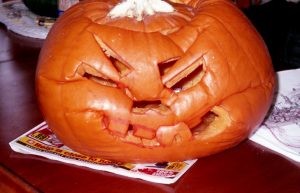Online Content
Halloween Origins and Its Superstitions
October, 2016

Some of you may know the history of our candy-induced, costumed holiday called Halloween, but for those who don’t, here’s a quick timeline for you.
Halloween was originally called Samhain, which is Celtic for “summer’s end.” At Samhain, the Celts said goodbye to the growing season (summer) and got ready for the dark season (winter). The night of October 31st, that division between summer and winter, was a big night for the Celts. This was when the barrier between the worlds of the living and the dead was at its thinnest. Some historians believe the early Celts thought the spirits of those recently departed, who were awaiting their time to cross over into the Summer Lands, would be able to cross back into living world, wander their old towns and visit with those whom they had left behind. However, these Celts also believed that these spirits might get too comfortable being back among the living. So, the living would light a large bonfire or tein in the centre of town. The bonfire would welcome the spirits, but would have the dual purpose in driving them off, too. Home hearths remained unlit so the spirit who used to reside there wouldn’t get too settled into its old ways.
When Christianity was on the rise across Europe, the leaders of the Christian faith, including the Catholic popes, knew the old, deeply rooted traditions of the pagans wouldn’t go easily. They decided to turn sites frequented by pagans into holy sites, festivals that celebrated Celtic gods now celebrated saints and special holidays for the pagans now became holy days for Christians. The tradition hardest to quell was Samhain. Lighting bonfires, talking to the dead, divining the future—these were well engrained with Samhain. The Catholic Church decided to alter the popular festival by claiming November 1st as All Saints Day then, a couple of centuries later, added November 2nd to be All Souls Day. During the times of the Reformation, All Hallows Eve was always in flux. During a royal Catholic reign, all Christian holidays and Halloween were allowed to be observed. During Protestant rule, all the holidays including Christmas and All Hallows Eve were stricken off the calendar and banned from being celebrated. Yet, when Protestant Elizabeth I took the throne, All Hallows Eve moved to November 5th and was called Bonfire Night, later to be called Guy Fawkes Night a few decades later.
As the centuries passed, All Hallows Eve became a night for dignified parties, especially during the Victorian era. Foretelling future romances was a popular parlour game for young girls and women. However, those who lived in the country still held onto the darker, supernatural beliefs around October 31st. Scottish and Irish immigrants to North America brought with them the traditions of Samhain/Halloween. The religious among the immigrants observed All Saints and All Souls Day, but a larger portion of the immigrant population enjoyed the more entertaining side of All Hallows Eve: mischief-making and begging for food door-to-door. In 1921, trick or treating began, and it revived the tradition of “guising,” whereby children dressed in scary costumes to ward off evil spirits; the younger children were happy with the candy they were given, while the older ones put all their energy into elaborate practical jokes. In 1950, though, a group of teenagers from Philadelphia went trick or treating, but instead of wanting candy, they collected money for UNICEF. This good deed spread across North America and soon became a new tradition at Halloween.
SOME ENDURING SUPERSTITIONS AND TRADITIONS
- Corn Dolls: In the Scottish Highlands, The Blue-Faced Hag or Cailleach Bheur was reborn every Samhain, bringing with her cleansing snows. She crept about, killing the last of the crops and made sure nothing grew during the winter. At Beltane (April 30th), an effigy of the Hag was burned in a ritual fire. Corn dolls, which are still made today, personify the Hag and are honoured in rural farming areas.
- Punkie Night: In Somerset, 1840, on All Hallows Eve the male villagers were exceptionally late in returning from the fields. Fearing the worst that evil spirits or witches had taken them, the women of the village made lanterns out of turnips—to light their way as well as to scare off any evil doers—and set out to locate the men and guide them home. Immigrants to North America found that turnips weren’t readily available, but pumpkins were. And so, the Jack-O’-Lantern was borne.
- Tar Barrel Running: In Ottery St. Mary, Devon on November 5th, men and boys of this village carry on the Samhain tradition—literally. The boys would set off the celebration by setting fire to small barrels of tar and rolling them about the village. In the evening, the men carry much larger tar barrels, also set alight, where tar pours out of the sides, resembling flaming horns, leaving a flaming trail of tar after the men.
- Guising: The Samhain tradition of disguising oneself to fool evil spirits morphed into guising. Kids and older boys would get decked out in outlandish costumes, blacken their faces and go door-to-door. They would beg for food or money, sing songs, recite poetry, but also cause mischief.
- Bobbing for Apples: Not much practiced nowadays, but this was a popular parlour game in its heyday. The rules went that the first person to get an apple without the use of their hands would be the first to marry. The one who would catch an apple on the first try would experience true love, but the one who catches an apple after many attempts would be fickle in his or her relationships. If a girl put her caught apple under her pillow on Halloween night, she would dream of her future husband.











